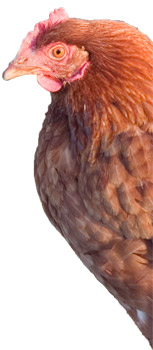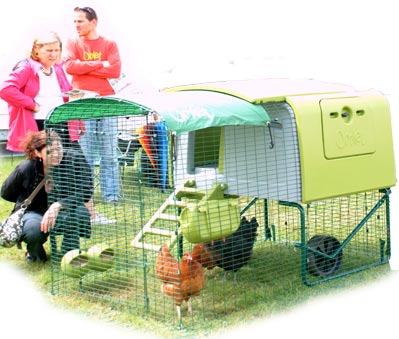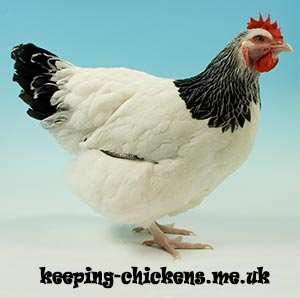Keeping a few chickens in the back yard really is quite straight forward; however there are some things to consider in order to get the right sort of birds for your situation and to keep them in the best possible health to get the most enjoyment out of keeping them.
This page hopes to get you thinking about the types of chickens and their requirements.
Choosing a breed
There are quite literally hundreds of different breeds of chicken to choose from and out of these, many have slightly different requirements.
Some breeds of chicken come only as Large Fowl, and others are also available as Bantams which are a smaller version that look the same. The Orpington for example is available in both large and bantam sizes but the Cochin is only available as large fowl.
There are a handful of ‘True Bantams’ where there is no large fowl equivalent. Examples of these are Dutch Bantams, Japanese Bantams and the popular Pekin Bantam.
Bantams tend to be quite flighty whereas the heavy breeds of large fowl often cannot fly more than a few inches off the ground. Orpingtons for example won’t usually roost very high due to their huge size and will usually just huddle on the floor of the coop.
Every breed is slightly different in the amount of eggs they lay. Typically hens that have been bred for exhibition purposes do not lay as well as utility hens. Bantams of course lay smaller eggs which some people say they prefer for taste.
Hybrids
 Hybrids are chickens that have been created by crossing pure breeds. They are typically crossed to make good layers (the hybrid to the right can lay 280 to 300 eggs!), coloured eggs or attractive hens. Some can be very attractive and they are all generally very hardy. Hybrids are produced in larger numbers that pure breeds and most of the crosses used make the males a different colour as day old chicks so that only females can be raised, therefore reducing costs by about half. A typical hybrid hen will cost you around £15 compare to £25 to £30 for a typical pure breed hen.
Hybrids are chickens that have been created by crossing pure breeds. They are typically crossed to make good layers (the hybrid to the right can lay 280 to 300 eggs!), coloured eggs or attractive hens. Some can be very attractive and they are all generally very hardy. Hybrids are produced in larger numbers that pure breeds and most of the crosses used make the males a different colour as day old chicks so that only females can be raised, therefore reducing costs by about half. A typical hybrid hen will cost you around £15 compare to £25 to £30 for a typical pure breed hen.
Hybrids are a good choice if eggs are one of your priorities although if you think you might like to hatch some eggs, remember hybrid hens do not breed true – you would need the original pure breeds to cross again in order to create more of the same thing so whilst you can hatch their eggs, you may want to consider a few pure breeds for this purpose or consider buying in eggs to hatch.
Free Range
You will of course need a chicken coop but also a secure run or area that is predator proof. A question that people always ask me is “How big should their run be?” I always say “as big as possible within reason.” Even 2 chickens kept in a 2 meter run will soon turn it to mud and get bored (which can introduce vices such as feather pecking and egg eating) but I always believe that it’s fine to provide a small run like this if you can let them out for a few hours each day to free range while you are around. This will give them a chance to forage, supplement their diet and reduce boredom.
Once chickens have settled into their new house, they will go back to it to roost every night so you can let them out in the late afternoon, knowing they will come back to roost at night keeping everyone happy! Some houses and runs have handles or wheels that make them easy to move onto fresh ground which is not only good to prevent a build up of worm eggs and disease but also provides them with a little fresh grass to graze.
Keeping Chickens in the Garden
If you have a ‘nice’ garden that you don’t want spoilt, it’s usually a sensible idea to limit their foraging. Chickens scratch at the ground, make dust baths in the dry soil, leave muck wherever they go and destroy tender young plants. If you can plant in pots, this will help and fencing off part of the garden is usually a good choice to keep them out if you have tender or precious plants. Chickens with feathered feet scratch less and bantams can clear a 6 foot fence if they want to. Heavy breeds of large fowl can be kept out with a knee high fence or box hedge. If you want to stop a bird from flying then you can clip one wing (not both).
So you have decided on the breed that’s right for you and your circumstances. Next, you will need to think about keeping them secure from predators in a suitable chicken house and chicken run – click on a link to go to that page!








Which is best to have a trio of hens or two for them to be happy and not picked on?
A trio is usually a cock and two hens in poultry speak.
Three hens would be better than two. Hens are happier in a small flock and if something were to happen to one, you still have a pair.
I have just acquired four ‘rescue’ hens from a farm. They have a secure coop, secure ground base. I have one of those mobile hen runs which i put them in when I can. The question is, I have clipped their wings on one side, but I am still nervous about letting them loose in the garden when I am around. One side of garden fence is 5 foot and the other is around 3ft. As i have clipped their wings, how high can they now jump / fly? I really don’t want to have to keep going to my neighbours to ask for my hens back!
It’s hard to say how high they can fly because each bird is different and the amount of feathers you clip will also have an effect. Lighter weight, bantam breeds can often fly quite well, whilst heavy breeds can hardly get off the ground.
Once settled, they won’t usually try to escape too much so I would release them an hour before dark to start with – that way, they will be back to roost. As you gain more confidence, you could extend this time.
Several years ago two of my lodgers had chickens in my garden. One of my present ones would like to have them again. I loved giving them the vegetable peelings. They rescued a hen which was dehydrated and it celebrated being alive by cock a doodle doo all night. Upsetting many neighbours. We would so love fresh eggs.
Great advice here for newbies to chicken keeping but also seasoned chicken keepers like myself! Thank you for sharing!
HI. We’re getting our first hens next spring. I’m trying to decide which to get and there’s so much advice out there, but all different! Confused – me? Anyway, we have a lovely hen house on legs, a 9ft run attached, with pitched roof. Hardwood bark on the floor to a good depth. It’s a static house as we have a small garden. We have no grass, but a gravel path with 4 borders yet to be planted. I love Orpingtons and had wanted a Buff Orpington, a Light Sussex and one other – I love Gold Laced varieties. We have small grandchildren that we’d like to be involved and it’s possible that the hens may have to be in the run most of the time. I want to let them out but with all I’ve read, I’m a bit nervous. OUr borders have a small box hedge around. There’s a 4 ft fence dividing off the veggie patch and 6 ft fencing all round the garden. I’ve been told that Bantams might be best for keeping in the run, but then you say they can fly over a 6ft fence if they choose!! I would be grateful for your thoughts and what you think about Bantams in this situation vs larger hens. I’m so looking forward to having some girls but I want to get it right. For them and for us! Thanks for reading.
Well, large hens like Orpingtons and (exhibition) Light Sussex could be let out and kept behind a fence that’s only a couple of feet high, but they take more space in a run and need a larger area really. Bantams can fly well so would easily get over small fences but wouldn’t have such a space requirement in the run, so you could potentially keep them in the run without letting them out.
I have know what you mean I have just got bantams and they are a bit of a hand full but well worth it!